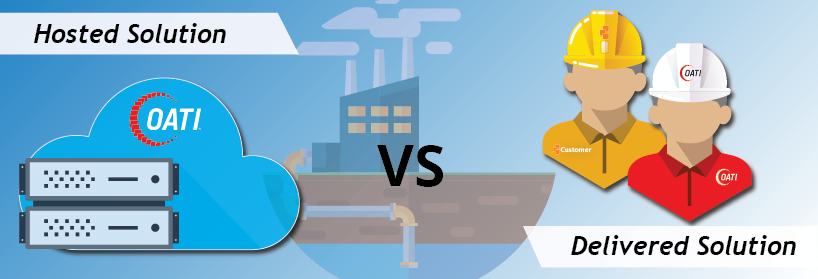Home » Blog » Trading & Risk Management » Hosted vs Delivered Solutions
Hosted vs Delivered Solutions
As technology grows, business needs change, and the search for optimum performing software systems continues. In the natural gas industry, as hosted solutions have reached commercial maturity, gas transportation and storage management operators are considering breaking away from delivered solutions. The question here is: when searching for a new software system, how does a company decide between a hosted and delivered solution?
For many business leaders who have expressed concerns about the security and cost of hosted solutions, the default has been to build or deploy in-house legacy systems. Given that many of these systems are becoming outdated, the trend toward hosted solutions is growing. In this blog, OATI provides a unique approach to hosted solutions. Decades of expert IT, product development and product deployment has shaped our ability to provide Saas-based natural gas pipeline management and natural gas trading solutions.
From an OATI perspective, the main difference between hosted versus delivered solutions is that one is hosted and maintained in OATI’s Data Centers, while the other is delivered to the customer site and managed by their IT staff. To analyze each solution, let’s take a look through the lens of a natural gas pipeline operator and see which solution would best solve your business needs.
Hosted Solution: This is a software-as-a-Service (SaaS) solution where OATI owns and operates all installations, upgrades, and maintenance within a shared cloud environment for the web-based applications. Your applications are securely hosted in two redundant, active/active data centers with synchronous data replication. Along with around the clock support from OATI experts, the following services are included in an OATI hosted solution:
- Monthly site failovers are conducted after hours with minimal service disruption to fully test and verify the disaster recovery plan.
- Data centers feature fully redundant power, cooling, and network facilities.
- Extensive physical security with biometric access control, video and environmental surveillance, motion detection and automated alarming.
- Extensive cyber security with redundant firewalls and network intrusion detection as well as centrally managed anti-malware software deployed to all servers with daily signature updates.
- Secured by using NAESB certified webCARES Digital Certificates, each login requires is encrypted via SSL/TLS or IPSEC VPN.
- Automated monitoring of application availability and performance.
- Automated log scraping and analysis from all server and network devices.
- Centrally managed server patching.
- OATI undergoes an annual SSAE16 Type II audit which tests cyber and physical security and policies. A copy of this report is provided to our customers annually.
Delivered Solution: In this option, customer IT staff and OATI deploy hardware and software solutions together to integrate with the existing Customer IT SAN/WAN. This requires OATI send staff to install the database and application. A delivered solution means the customer has direct control and maintenance of the database and handles all maintenance of hardware. If you choose a delivered, the hosting environment should include:
- Physical security to limit access to designated personnel and network firewall in place to limit network access to the system.
- Sufficient cooling and electrical capacity for a rack server environment.
- UPS and/ or generator back-up power.
- An available server rack.
- Redundant network switching with gigabit switch ports.
- Keyboard, monitor and mouse available – this could be through a crash cart or through a KVM device.
- SNMP monitoring system to detect server hardware faults.
- Anti-virus software, backup, patching and other relevant system administration processes in place.
- A disaster recovery Data Center with similar capabilities is recommended.
When comparing natural gas hosted versus delivered solutions, it’s important to focus on security. Unlike other cloud service providers, OATI controls infrastructure, platform, and software across dual data centers. These centers are wholly owned and operated by OATI. Controlling the physical resources supporting our mission-critical applications offers the ability for OATI staff to diagnose and resolve issues in less time than other providers who outsource to third party providers. OATI hosts and maintains systems for NAESB in this environment for example, plus thousands more customers.
It’s also important to weigh the costs of the two choices. A hosted solution is less expensive and more secure. As your data is housed in OATI’s Data Centers, ther is no cost for additional IT staff, maintenance, or software. Users can also access the application from anywhere online.
On the flip side, a delivered solution is more costly and less secure. The customer has to purchase servers and software, maintain the systems, and provide security, not to mention a disaster recovery environment at a third-party hosted site. Accessing the application is done with a through a third party interface, so the user has yet another login. Our experts would be happy to work with you to provide a Total Cost of Ownership (TCO) on a hosted solution and uncover the hidden costs of a delivered solution.
We provided the basis of a hosted vs delivered solution, but the choice is ultimately yours. If you need more information or help making this critical decision, read our blog posts on SaaS Benefits and email sales@oati.net to get expert advice.
About the author
Sheldan Perry is a highly skilled professional with more than 25 years of detailed functional and technical knowledge in oil and gas, pipeline transportation, and energy software development. Sheldan is currently the Manager of Gas Systems at OATI and is responsible for coordinating the continuous enhancement of our natural gas transportation management system to meet the ever changing regulatory requirements and maintaining the existing gas management system.
- December 13, 2017
